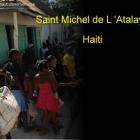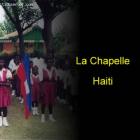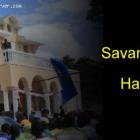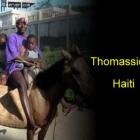ADVERTISEMENT
Land - Haiti Observer Blog
Land, Haiti Observer Blog. Read the following articles about Land
Haiti Agricultural Facts, land and environment
The Tide Turning for Haiti's Ailing Environment. Haiti's environment has suffered an extreme degree of deterioration, nearly unparalled globally. Once blanketed with virgin forests, its canopy only covers 4% of its land mass today. Without forest protection and seasonal heavy rains, topsoil gets sloughed off, creating flood conditions.
Haiti's agriculture sector is one of its largest, and should be the mainstay of the country's economy, but many factors, historical, social, political, and environmental have undermined its ability to thrive. Haiti at one time was the #1 exporter of coffee, and also exported enormous amounts of sugar cane. Global competition in both areas priced them out of the market.
Haitian President Alexandre Petion, gens de couleur libres
Born a member of the gens de couleur libres, Alexandre Sabes Petion (1770 - 1818) began life between two worlds. It is a dichotomy he would continue, further marking his legacy as an instrumental force behind the struggle for independence of two lands, his own beloved Haiti, and the republic of Gran Colombia.
Alexandre Petion began his career, after an expensive education in France, by joining the fight to force the British out of Saint-Domingue between 1798 and 1799. He would subsequently fight on the side of the mulattos against Toussaint L'Ouverture and the blacks, and was exiled to France when the rebellion ended; he returned soon after with General Leclerc and his assemblage of warships and troops. In 1802, he joined the nationalist force and gave his support to Jean-Jacques Dessalines, the future proclaimer of the Haitian Independence and self-declared ruler for life of the newly formed country.
Solutions for Deforestation Blocked by Government Incompetence
The island of Haiti was once blanketed by forests. Foreign countries, though, raped the land over many decades. During the era after America was founded, forests had decreased 5%, and during the French occupation, they declined another 45%. By 1956, only 20% remained. By the end of the 1980s, the percentage dropped to 2% left of forested terrain.
Zile Ayiti te yon fwa rekouvèr pa forè. Peyi etranje yo, fe kadejak sou peyi a pandan plizie deseni. Pandan epòk apre Amerik te fonde, forè te diminye 5%, ak pandan okipasyon Franse, yo te diminye yon lòt 45%. Le ou rive nan 1956, sèlman 20% rete. Rive nan fen 1980 yo, pousantaj la tonbe nan 2% kite nan tèren forè.
Jean Dominique and the Aristide Era
Jean Dominique spent his early career first educating farmers on how to be self-sufficient under the thumb of wealthy land-owners. He then went on to making two notable firsts in the broadcasting world, opening the first film club in Haiti as well as Radio Haiti, the first station to broadcast in Creole. He went on to have multiple run-ins with the Duvalier regiments and was exiled in New York until his return in the mid 80's when he became a member of the Lavalas party which won the 1990 election.
Selling Land to multiple Buyers, a problem in Haiti
Many reasons exist as to why reconstruction efforts in Haiti are dragging: pledges reneged on, mis-spending, and lack of transparency. The latest obstacle to reconstruction projects is leniency in Haiti's National Land Registry Office (NLRO) regulations.
The problem with land-registry procedures began in 1804, the year of Haiti's independence from French rule. Haiti's second president, Jean-Jacques Dessalines, urged land reform as part of his platform. But in intervening years up until the present, a loophole in the NLRO's procedural guidelines has indirectly caused stalled road reconstruction and other infrastructure projects in Haiti.
Protocol for land transfers includes inspection, notarization, and fulfillment of tax assessor requirements. Bypassing bureaucratic red tape and exorbitant fees, land owners have devised their own land-transfer strategies.
Elie Lescot and the SHADA Project
During WWII when the Axis Powers managed to cut off the Eastern rubber supply, the then Haitian President, Elie Lescot proposed an ambitious to USA. He proposed to rapidly increase the rubber production during the war period in the countryside of Haiti. $5 million was granted by Washington's Export-Import Bank in 1941 so that rubber plantation can be developed in Haiti. This ambitious program was named at Société Haïtiano-Américane de Développement Agricole or SHADA. Thomas Fennell, an American agronomist managed the SHADA program.
Using US military support, Lescot administration cleared 47,177 acres of land by 1943 with the purpose of planting high latex-yielding cryptostegia vine. Over time, 100,000 hectares of land were claimed by the SHADA project. During this period, Elie Lescot campaigned and sold people the idea that SHADA will only improve and modernize agriculture in Haiti. However, Haitian families were forcibly removed from arable lands and nearly a million trees capable of bearing fruit were cut down.
Our objective is to share with you news and information about Haiti and the people of Haiti. Traditions, habits and the way we were or grew are alive in this site. We highly recommend that you Subscribe to our Newsletter and also share with us some of the things that are memorable and made us unique people.

 Saint Michel de L 'Atalaye
Saint Michel de L 'Atalaye  La Chapelle, Haiti
La Chapelle, Haiti  The Town of Savanette, Haiti
The Town of Savanette, Haiti  Thomassique, Haiti
Thomassique, Haiti  Saint Marc, Haiti
Saint Marc, Haiti